knife4j入门
Posted G_whang
tags:
篇首语:本文由小常识网(cha138.com)小编为大家整理,主要介绍了knife4j入门相关的知识,希望对你有一定的参考价值。
偶然在公众号看到大佬发的文章,看到了这个knife4j 感觉很不错,就上手尝试了下,果然非常好用,界面很好看,集中了postman和Swagger的一些优点,支持接口文档生成与导出,支持配置全局变量等等。。。
使用springboot集成knife4j
如果使用Knife4j2.0.6及以上的版本,Spring Boot的版本必须大于等于2.2.x
所以本次演示使用了2.2.1版本的spring Boot
pom引入
<!--使用Knife4j2.0.6及以上的版本,Spring Boot的版本必须大于等于2.2.x 不然会有jar包冲突-->
<dependency>
<groupId>com.github.xiaoymin</groupId>
<artifactId>knife4j-spring-boot-starter</artifactId>
<version>2.0.9</version>
</dependency>
配置文件
knife4j:
# 开启增加配置
enable: true
# 开启生产环境屏蔽
production: false
# 开启Swagger的Basic认证功能,默认是false
basic:
enable: true
# Basic认证用户名
username: test
# Basic认证密码
password: 123
配置类
import com.github.xiaoymin.knife4j.core.util.CollectionUtils;
import org.springframework.context.annotation.Bean;
import org.springframework.context.annotation.Configuration;
import springfox.documentation.builders.ApiInfoBuilder;
import springfox.documentation.builders.OAuthBuilder;
import springfox.documentation.builders.PathSelectors;
import springfox.documentation.builders.RequestHandlerSelectors;
import springfox.documentation.service.*;
import springfox.documentation.spi.DocumentationType;
import springfox.documentation.spi.service.contexts.SecurityContext;
import springfox.documentation.spring.web.plugins.Docket;
import springfox.documentation.swagger2.annotations.EnableSwagger2WebMvc;
import java.util.ArrayList;
import java.util.List;
@Configuration
@EnableSwagger2WebMvc
public class Knife4jConfiguration {
@Bean(value = "defaultApi2")
public Docket defaultApi2() {
//schema
List<GrantType> grantTypes=new ArrayList<>();
//密码模式
String passwordTokenUrl="http://192.168.1.10:8080/oauth/token";
ResourceOwnerPasswordCredentialsGrant resourceOwnerPasswordCredentialsGrant=new ResourceOwnerPasswordCredentialsGrant(passwordTokenUrl);
grantTypes.add(resourceOwnerPasswordCredentialsGrant);
OAuth oAuth=new OAuthBuilder().name("oauth2")
.grantTypes(grantTypes).build();
//context
//scope方位
List<AuthorizationScope> scopes=new ArrayList<>();
scopes.add(new AuthorizationScope("read","read all resources"));
SecurityReference securityReference=new SecurityReference("oauth2",scopes.toArray(new AuthorizationScope[]{}));
SecurityContext securityContext=new SecurityContext(CollectionUtils.newArrayList(securityReference),PathSelectors.ant("/api/**"));
//schemas
List<SecurityScheme> securitySchemes=CollectionUtils.newArrayList(oAuth);
//securyContext
List<SecurityContext> securityContexts=CollectionUtils.newArrayList(securityContext);
Docket docket=new Docket(DocumentationType.SWAGGER_2)
.apiInfo(new ApiInfoBuilder()
.title("swagger-bootstrap-ui-demo RESTful APIs")
.description("# swagger-bootstrap-ui-demo RESTful APIs")
//.termsOfServiceUrl("http://www.xx.com/")
.contact("gwh@qq.com")
.version("1.0")
.build())
//分组名称
.groupName("2.1版本")
.select()
//这里指定Controller扫描包路径
.apis(RequestHandlerSelectors.basePackage("com.example.knife4jspringbootfastdemo.controller"))
.paths(PathSelectors.any())
.build();
return docket;
}
@Bean(value = "defaultApi1")
public Docket defaultApi1() {
Docket docket=new Docket(DocumentationType.SWAGGER_2)
.apiInfo(new ApiInfoBuilder()
.title("swagger-bootstrap-ui-demo RESTful APIs")
.description("# swagger-bootstrap-ui-demo RESTful APIs")
//.termsOfServiceUrl("http://www.xx.com/")
.contact("gwh@qq.com")
.version("1.0")
.build())
//分组名称
.groupName("2.2版本")
.select()
//这里指定Controller扫描包路径
.apis(RequestHandlerSelectors.basePackage("com.example.knife4jspringbootfastdemo.controller"))
.paths(PathSelectors.any())
.build();
return docket;
}
}
测试类
import com.example.knife4jspringbootfastdemo.pojo.User;
import com.github.xiaoymin.knife4j.annotations.ApiOperationSupport;
import io.swagger.annotations.Api;
import io.swagger.annotations.ApiImplicitParam;
import io.swagger.annotations.ApiOperation;
import org.springframework.http.ResponseEntity;
import org.springframework.web.bind.annotation.*;
@Api(tags = "测试1")
@RestController
public class IndexController {
// 传递参数校验
@ApiImplicitParam(name = "name",value = "姓名",required = true)
// 可加接口开发作者, 加排序
@ApiOperationSupport(author = "gwh",order = 1)
// 方法描述
@ApiOperation(value = "向客人问好")
@GetMapping("/sayHi")
public ResponseEntity<String> sayHi(@RequestParam(value = "name")String name){
return ResponseEntity.ok("Hi:"+name);
}
@ApiImplicitParam(name = "name",value = "姓名",required = true)
@ApiOperationSupport(author = "gwh",order = 2)
@ApiOperation(value = "向客人挥手")
@GetMapping("/byebye")
public ResponseEntity<String> byebye(@RequestParam(value = "name")String name){
return ResponseEntity.ok("bye-bye:"+name);
}
// 使用自定义增强注解ApiOperationSupport中的ignoreParameters属性,可以强制忽略要显示的参数.
// 例如新增接口时,某实体类不需要显示Id,即可使用该属性对参数进行忽略.ignoreParameters={"id"}
// 如果存在多个层次的参数过滤,则使用名称.属性的方式,例如 ignoreParameters={"uptModel.id","uptModel.uptPo.id"},其中uptModel是实体对象参数名称,id为其属性,uptPo为实体类,作为uptModel类的属性名称
// 如果参数层级只是一级的情况下,并且参数是实体类的情况下,不需要设置参数名称,直接给定属性值名称即可
// 如果是JSON 请求的话需要加上一级参数名
@ApiOperationSupport(author = "gwh",order = 3,ignoreParameters={"user.number"})
@ApiOperation("获取用户数据")
@PostMapping("/getUser")
public User getUser(@RequestBody User user){
return user;
}
// 使用自定义增强注解ApiOperationSupport中的includeParameters属性,可以强制包含要显示的参数.去除多余的参数显示
// 新增接口时,某实体类不需要显示Id,即可使用该属性对参数进行忽略.includeParameters={"id"}
// 如果是JSON请求的话 需要把一级参数名称带上
@ApiOperationSupport(author = "gwh",order = 5,includeParameters = {"user.number"})
@ApiOperation("获取用户数据")
@PostMapping("/getUser1")
public User getUser1(@RequestBody User user){
return user;
}
}
启动项目
访问http://localhost:8080/doc.html

因为有配置Basic认证 所以需要输入认证的账号和密码
登录成功可以看到首界面

查看应用中的实体类

可以配置全局参数
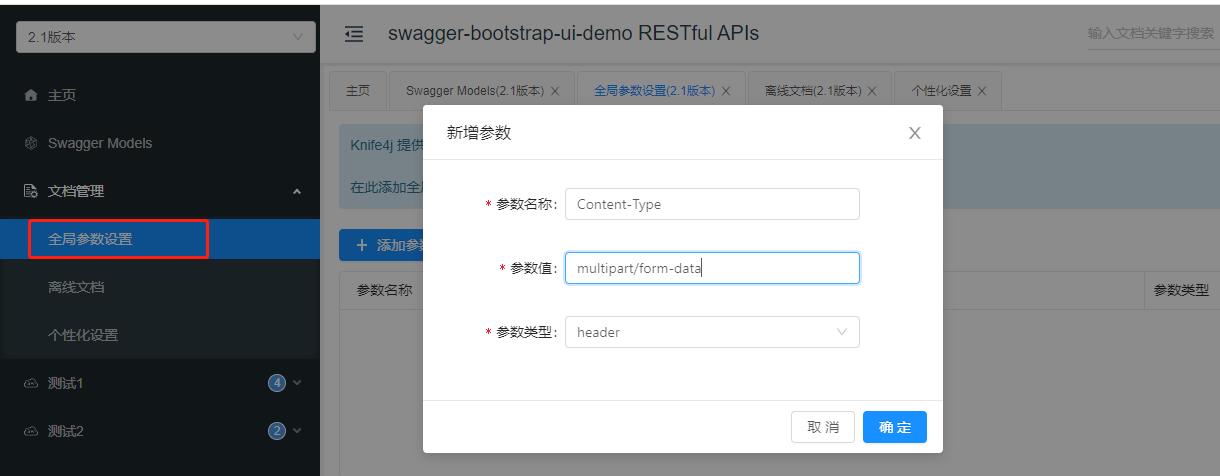
可以下载各种格式的文档

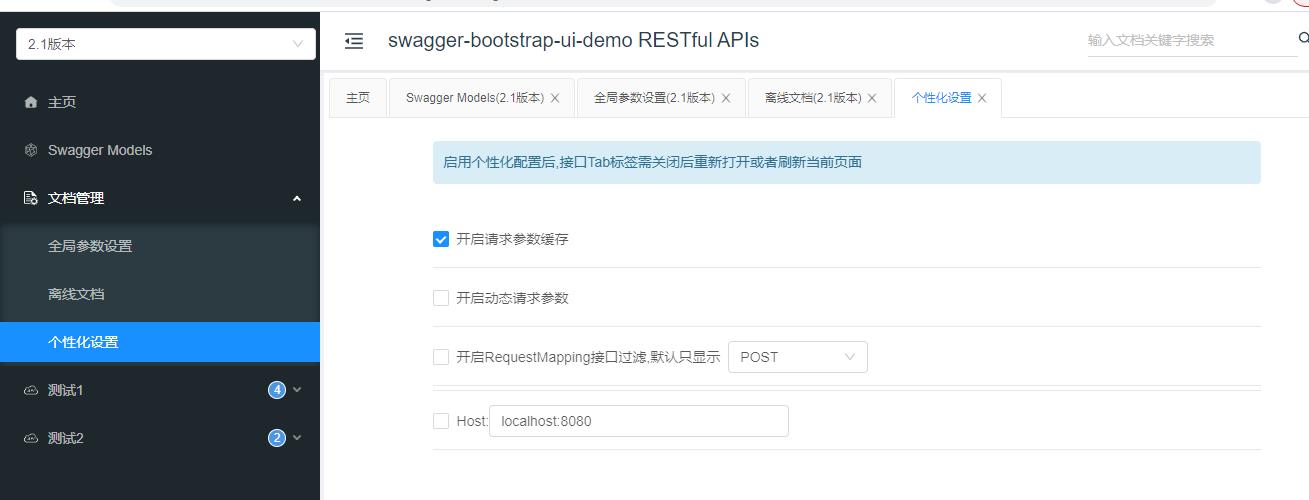
接口调试
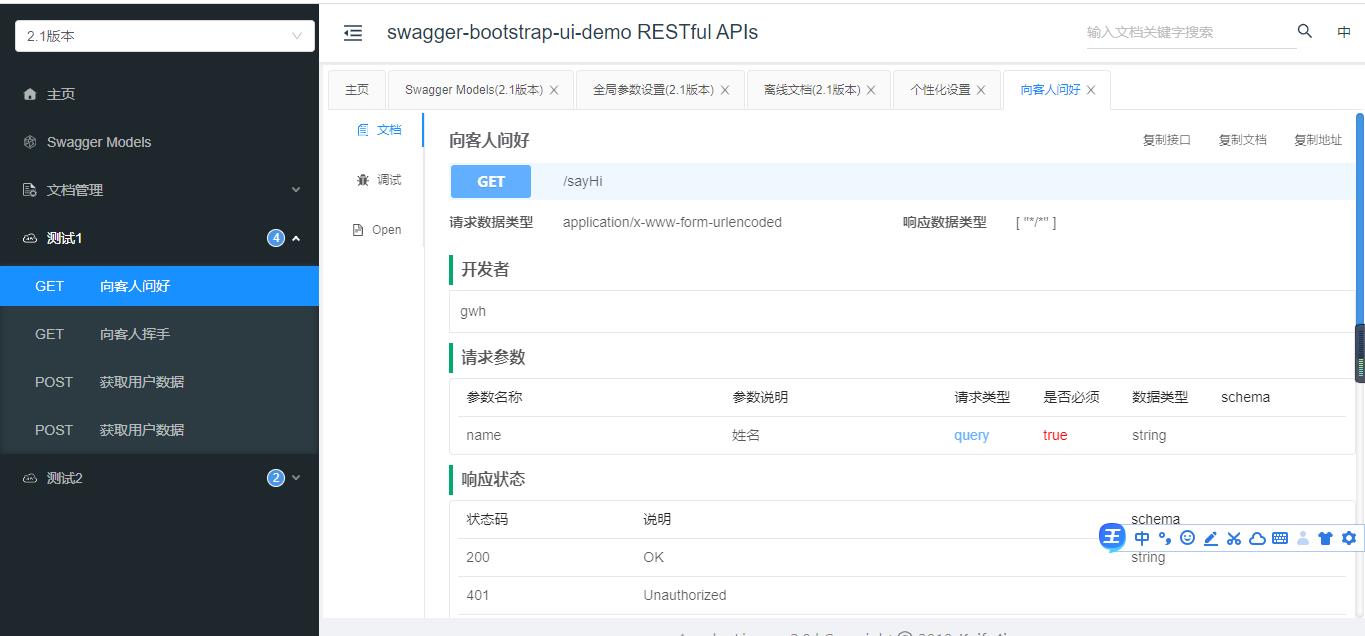
点击调试按钮 因为本请求用不到刚才增加全局变量设置的头部配置,所以把该参数去掉

设置参数,点击发送即可
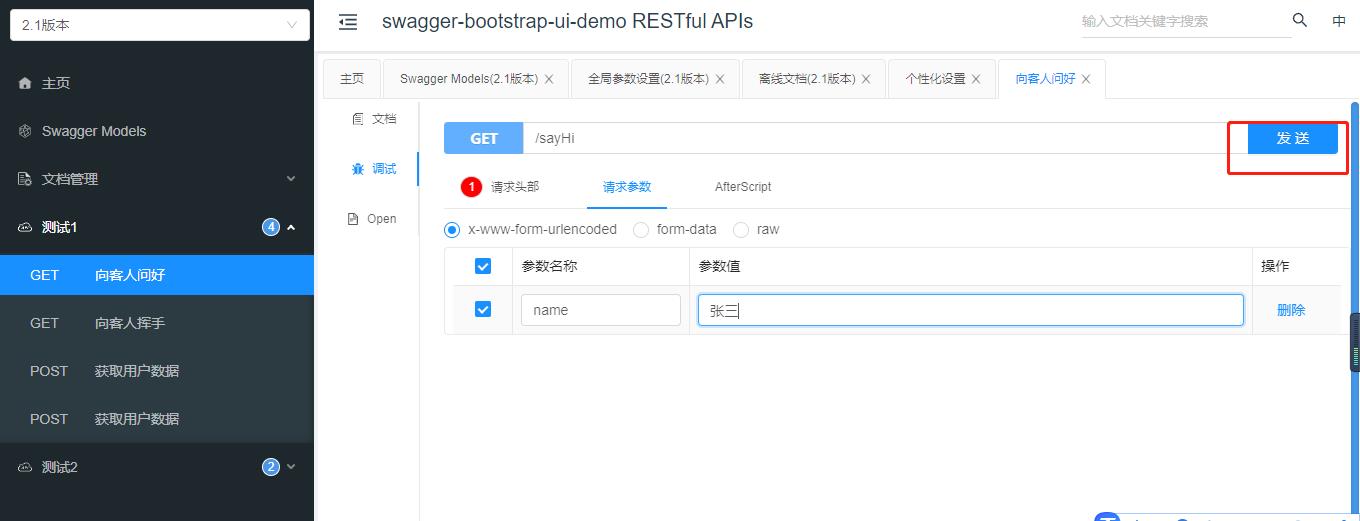
相信会使用swagger的肯定可以立马上手
如果是post请求的话还可以设置参数为json
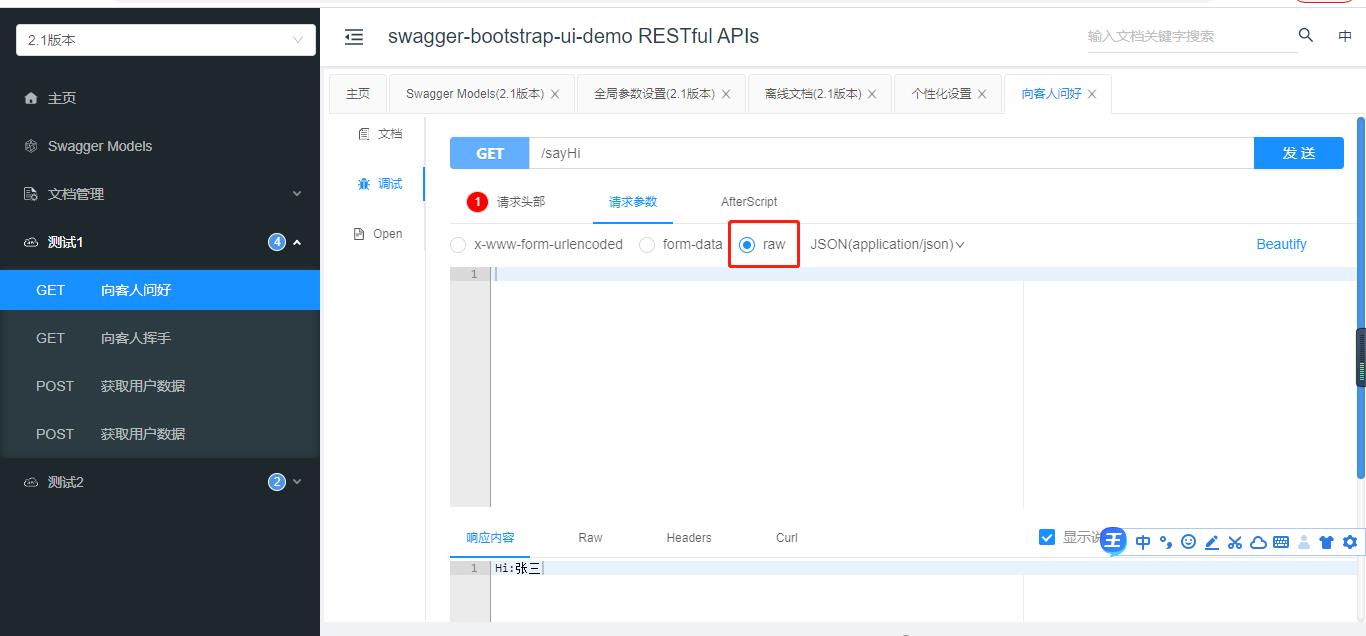
也支持文件类型参数调试
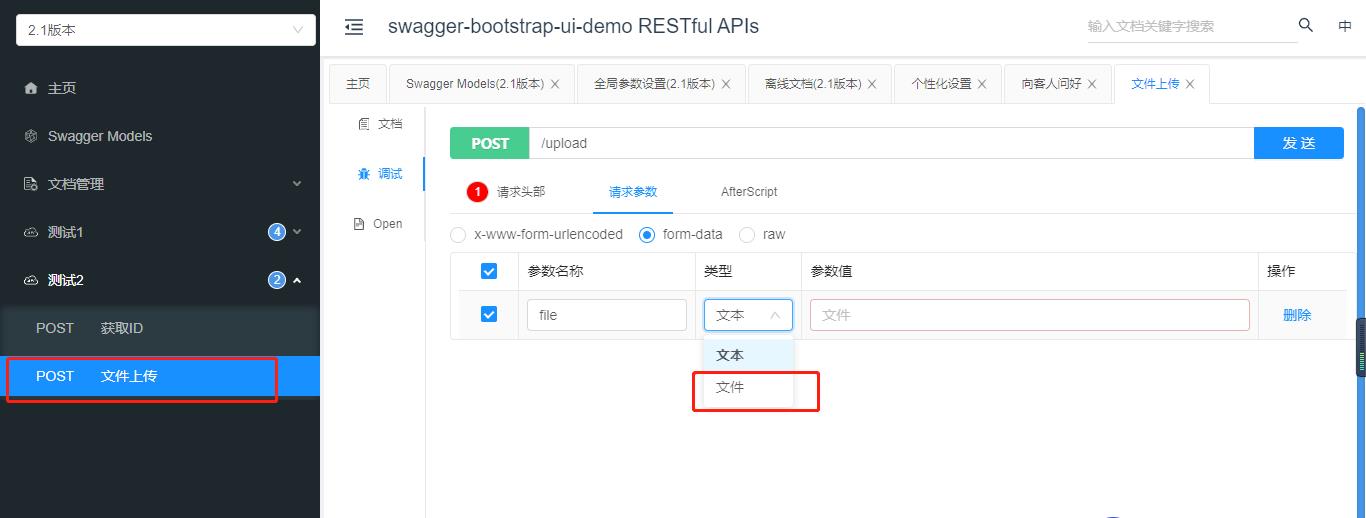
完整测试代码
https://github.com/Gwhang/knife4j-spring-boot-fast-demo
knife4j 官方文档
https://doc.xiaominfo.com/knife4j/documentation/
以上是关于knife4j入门的主要内容,如果未能解决你的问题,请参考以下文章